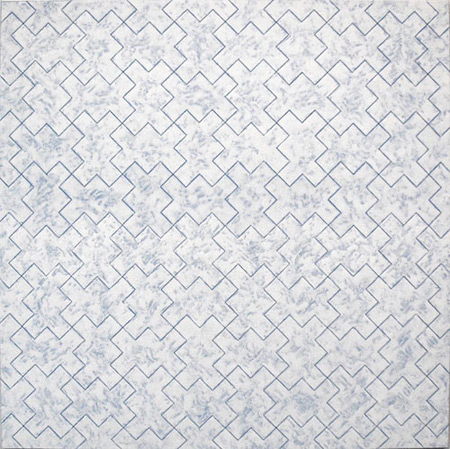
Continuing through April 13, 2013
In 1971 John Baldessari filmed "Six Colorful Inside Jobs," which consists of an overhead shot of a journeyman house painter painting the walls of a closet-size room in primary and secondary colors over the course of six days, one color over the other. In the same time span that Biblical authority claims it took God to create the world, Baldessari's house painter alter ego first buried the default white of the bare walls, and then applied succeeding layers of fresh paint, simultaneously adding and erasing in a potentially endless progression.
Baldessari was a leader but hardly unique in laying stress on the performative aspect of painting. If anything, from Yves Klein to Paul McCarthy, the act of painting has been subjected to a progressive desublimation that has reduced its performative options to tiresomely repeated acts of public besmirching. This tendency equates performative intensity with aggression. In its infancy it resonated with broader countercultural transgressions aimed at questioning assumptions of patriarchal authority. Today, after endless variations, it has come to signify that authority itself and its bottomless appetite for gross spectacle.
In this context, the value of a steadfast, low-key performer like Stephen Beal is to reacquaint one with the intensity of steadfastness itself, in particular Beal's ability to amplify the minutest and seemingly inconsequential gesture through repetition. This is how most of us leave our mark on the world, for the most part unconsciously. Beal has dedicated himself to doing it mindfully.
Because Beal's algorithmically generated monochromes and all-over patterns require both discipline and fastidiousness as well as an appreciation of repetition as rhythm, they inevitably provoke, by way of appreciation, recourse to the by-now hackneyed vocabulary of Eastern meditation practices, whose exoticism once succored the residue of the contemplative impulse that remained in Western art after Pop and minimalism banished depth. To me, however, Beal's scribed surfaces seem more closely related to well-turned joinery or marquetry, particularly in the case of the works collectively entitled "The Linens," in which unpainted areas of bare linen alternate with precisely delineated passages of translucent white.
Visually dazzling in their play of earthiness against luminosity, what makes them compelling is the analogy they set up between the translucency of the applied paint and the transparency of their fabrication, with un-erased pencil lines peering through the paint to reveal the solid logic that underlies their patterning. While the visual rhythms may suggest musical performance, the translucency brings to the stage a dignity peculiar to people whose persistence is revealed in their exacting craft and, specifically, in the grace and mindfulness they bring to repetitive motions that might easily be dismissed as drudgery. (This sympathy that enables some artists to apprehend their commonality with manual workers goes at least as far back as Courbet and is beautifully staged in Gustave Caillebotte’s "The Floor Scrapers," where the brushiness of the Impressionist mark doubles as the parallel streaks produced by the workmen on the wood floor.)
With the series “The Whites,” we are in the realm of the white monochrome, which has exercised an enduring fascination on painters, perhaps because white, besides being the most luminous of pigments, is also the ground on which all paintings are built (and on which they hang). It is the color that seems most closely associated with emergence. In his take on the white monochrome, Beal seems to emphasize the materiality of the pigment via the variability of its power of coverage. Rather than produce an undivided surface that can function as a screen (as Rauschenberg’s white canvases were able to do and as the default white of the white cube does), Beal’s white is a clay-like fluid that pools unevenly and produces a mottled surface on which he inscribes patterns that are suggestive of tile work. Thus, the seeming self-organization of the uneven white is contrastingly paired with the deliberate articulation imposed by the elaborate grids. The performance on view is yet another variation on mindful matter-of-factness. But the visual effect leans more markedly toward decoration by virtue of its all-over symmetry. Seen in reduced format as jpegs, the patterning is reduced to an overly simplified surface effect; these are paintings that have to be viewed live in order for the timbre of their performance to register.
